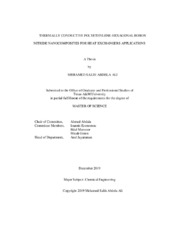| dc.description.abstract | Compared to metals, polymers are less susceptible to corrosion and scale formation caused by high salinity water. Therefore, replacing metals with polymers in heat exchangers that use seawater would result not only in mitigating the corrosion problems but also in substantial cost savings because of the low price and density of polymers. However, the low thermal conductivity of polymers must be significantly increased for their application as heat transfer surfaces. Herein, thermally conductive polyethylene nanocomposites based on hexagonal boron nitride (h-BN) and their 2-D exfoliated nanosheets were prepared by melt blending using twin-screw extruder and dry mixing using ball milling. h-BN was successfully exfoliated to h-BNNS via ball milling technique. In addition, h-BN exfoliation was optimized by studying the effect of milling time on the h-BN crystallite size, particle thickness, and h-BNNS yield. Subsequently, the impact of h-BN sheet size, thickness, and loading as well as the h-BN composite processing method on the physical and thermomechanical properties of polyethylene (PE) composites were studied. It was found that the incorporation of h-BN enhanced the thermal conductivity, thermal stability, and mechanical properties of PE composites. Moreover, milled h-BN/PE composites showed better thermal conductivity and mechanical properties improvement compared to the bulk h-BN/PE composites. After successfully aligning h-BN particles, maximum thermal conductivity enhancement of over 1300 % was achieved. Conversely, the incorporation of h-BN was detrimental to the wettability of h-BN/PE composites. Nevertheless, the wettability of the composites was improved by plasma treatment.
Particularly, the CA of 50 wt. % h-BN/LLDPE composite decreased from 107.6º±2.57º in the untreated to 21.05º±2.34º after the plasma treatment. Furthermore, this treatment showed only slight deterioration with aging demonstrating good applicability. Our results indicate that low cost polymer heat exchanger for seawater desalination can be a reality | en |


